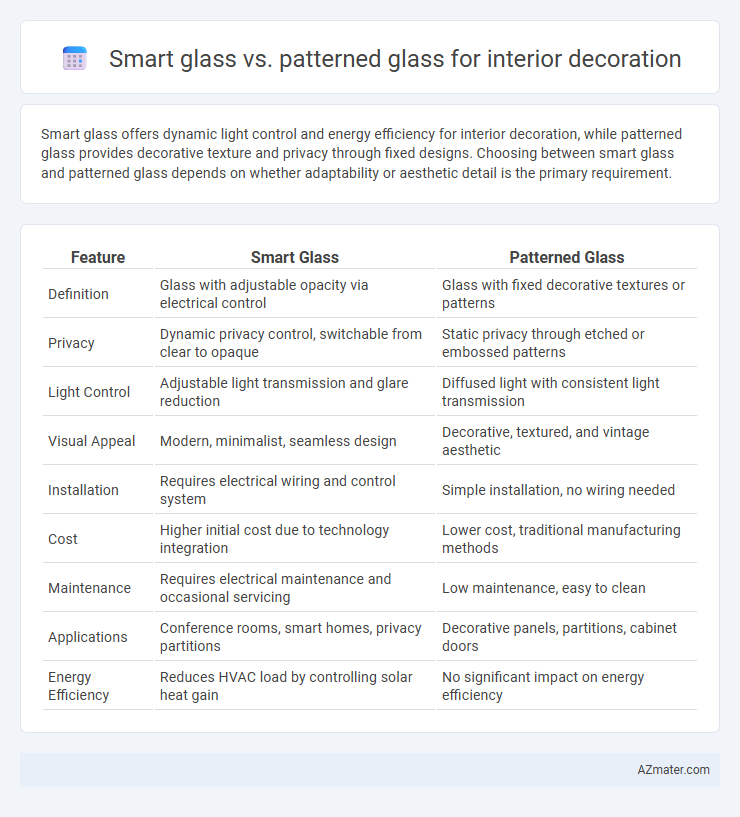Smart glass offers dynamic light control and energy efficiency for interior decoration, while patterned glass provides decorative texture and privacy through fixed designs. Choosing between smart glass and patterned glass depends on whether adaptability or aesthetic detail is the primary requirement.
Table of Comparison
| Feature | Smart Glass | Patterned Glass |
|---|---|---|
| Definition | Glass with adjustable opacity via electrical control | Glass with fixed decorative textures or patterns |
| Privacy | Dynamic privacy control, switchable from clear to opaque | Static privacy through etched or embossed patterns |
| Light Control | Adjustable light transmission and glare reduction | Diffused light with consistent light transmission |
| Visual Appeal | Modern, minimalist, seamless design | Decorative, textured, and vintage aesthetic |
| Installation | Requires electrical wiring and control system | Simple installation, no wiring needed |
| Cost | Higher initial cost due to technology integration | Lower cost, traditional manufacturing methods |
| Maintenance | Requires electrical maintenance and occasional servicing | Low maintenance, easy to clean |
| Applications | Conference rooms, smart homes, privacy partitions | Decorative panels, partitions, cabinet doors |
| Energy Efficiency | Reduces HVAC load by controlling solar heat gain | No significant impact on energy efficiency |
Introduction to Smart Glass and Patterned Glass
Smart glass utilizes advanced technology to control light transmission and privacy through electrochromic, photochromic, or thermochromic properties, offering dynamic adaptability in interior decoration. Patterned glass features textured or embossed designs that provide decorative aesthetics and diffused light, enhancing privacy without compromising natural illumination. Both materials serve distinct functional and stylistic roles, with smart glass prioritizing technological innovation and flexibility, while patterned glass emphasizes artistic design and subtle light manipulation.
Defining Smart Glass: Features and Functions
Smart glass, also known as switchable glass, offers dynamic control over light and privacy through electronic tinting technology, enabling users to adjust transparency levels instantly from clear to opaque. Its features include energy efficiency by reducing glare and heat transmission, ultraviolet (UV) protection, and enhanced privacy without the need for blinds or curtains. In contrast to patterned glass, which relies on static textures or designs etched or printed into the surface for decorative appeal, smart glass provides functional adaptability, making it ideal for modern interior decoration focused on versatility and interactive user experience.
What is Patterned Glass? Styles and Applications
Patterned glass features textured surfaces created through rolling or pressing techniques, offering privacy and decorative appeal in interior spaces. Common styles include rain, reed, stippled, and floral patterns, each providing unique light diffusion and aesthetic effects. These versatile glass types are widely used in doors, partitions, shower enclosures, and cabinetry to enhance style while maintaining functionality.
Aesthetic Appeal: Visual Impact in Interior Spaces
Smart glass offers a sleek, modern aesthetic with its ability to switch between transparent and opaque states, creating dynamic visual effects that enhance privacy and light control in interior spaces. Patterned glass delivers a timeless decorative element through intricate textures and designs that diffuse light and add depth, complementing traditional and contemporary decor alike. The visual impact of smart glass lies in its versatility and innovation, while patterned glass provides consistent elegance and tactile interest, making each ideal for different interior design goals.
Privacy Solutions: Comparing Effectiveness
Smart glass offers dynamic privacy control by switching from transparent to opaque with an electrical signal, providing customizable privacy on demand. Patterned glass delivers static privacy through etched or embossed designs that obscure visibility while allowing light transmission. Smart glass excels in flexibility and control, whereas patterned glass provides consistent privacy with decorative appeal.
Light Control and Energy Efficiency
Smart glass offers dynamic light control through electrochromic technology, allowing users to adjust transparency and reduce glare instantly, which significantly enhances energy efficiency by minimizing HVAC load. Patterned glass provides fixed light diffusion and privacy with decorative textures, scattering light to soften interior brightness but lacks adjustable control, resulting in less optimized energy savings. The adaptive nature of smart glass makes it superior in managing daylight and thermal performance, leading to improved interior comfort and reduced energy consumption compared to patterned glass.
Installation and Maintenance Considerations
Smart glass installation requires professional electrical wiring and integration with control systems, while patterned glass involves simpler fitting similar to traditional glass panes. Maintenance of smart glass demands occasional software updates and careful cleaning to avoid damaging the electronic components, whereas patterned glass mainly needs regular cleaning to preserve its decorative finish. Both types offer durability, but smart glass may incur higher long-term maintenance costs due to its advanced technology.
Cost Comparison: Budget vs. Value
Smart glass typically involves higher upfront costs due to advanced technology and installation complexity, making it a premium option for interior decoration. Patterned glass offers a more affordable budget-friendly alternative, providing aesthetic appeal without the high price tag of smart functionality. Evaluating cost versus value, smart glass delivers enhanced privacy, light control, and modern sophistication that can justify investment in upscale settings, whereas patterned glass maximizes decorative impact within tighter budget constraints.
Best Use Cases: Where Each Option Shines
Smart glass excels in dynamic environments such as offices and conference rooms, offering privacy on demand and energy efficiency through light regulation. Patterned glass is ideal for decorative elements like partitions, doors, and shower enclosures, enhancing aesthetics with intricate designs and texture while maintaining partial visibility. Both options serve unique roles: smart glass focuses on adaptability and functionality, whereas patterned glass emphasizes style and visual interest in interior decoration.
Conclusion: Choosing the Right Glass for Interior Decoration
Smart glass offers dynamic control over privacy and light, making it ideal for modern interiors requiring flexibility and energy efficiency. Patterned glass provides aesthetic texture and design variety, enhancing traditional or decorative spaces with visual interest. Selecting the right glass depends on the desired functionality and style, balancing innovation and artistic expression for optimal interior ambiance.

Infographic: Smart glass vs Patterned glass for Interior decoration
 azmater.com
azmater.com